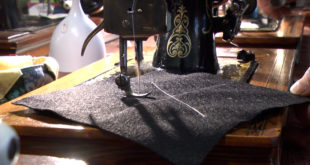Following Monday’s press conference, area sheriff departments quickly began training with Project Lifesaver equipment. Tuesday through Thursday, representatives from Houghton, Baraga, Ontonagon, and Keweenaw Counties, plus Superior Search and Rescue, were familiarized with the transmitter and receiver used by the program, and put through their paces out in the field.
Sara McCormick is a member of the Wood County Sheriff’s Department in central Wisconsin. She conducts training throughout the Midwest. Her department adopted Project Lifesaver after an incident similar to what happened in Ontonagon County with Cam Besonen.
By day three, McCormick was hiding dozens of wristbands throughout Houghton and Hancock for officers to find.
Project Lifesaver bands use radio frequency technology. Terrain and weather can affect performance, but a band will register from as far away as one mile. There are ways to switch from long to short scanning, but the receiver cannot tell you exactly how far away a signal is. McCormick says techniques exist to compensate for that, involving two people working in tandem. One will lock in, and then the other does the same about 250 to 500 feet ahead. They alternate until they’ve closed in on the target.
McCormick’s goal was to train others to the point where they can go to the rest of their department and become instructors for their peers. Right now, families are encouraged to express interest with their respective county sheriff. The first 50 families to register have all upfront costs paid for courtesy of a Portage Health Foundation grant. Wristbands will be delivered by December.
McCormick and Houghton County’s Charlie Klein will be on Copper Country Today Sunday morning.
 Keweenaw Report Your Source for Local News and Sports
Keweenaw Report Your Source for Local News and Sports





